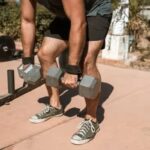Is sweating during exercise a sign of fitness? This is a common question that many people have, and it’s important to understand the relationship between sweating and physical fitness. In this article, we will explore the misconception surrounding sweating and fitness, as well as delve into the science behind sweat production and its connection to exercise.
Sweating is often perceived as a measure of how hard someone is working out or their level of physical fitness. However, this is not necessarily true. While the amount you sweat during a workout can vary based on different factors, it is not an accurate indicator of one’s fitness level. It’s crucial to debunk this myth and understand the true significance of sweating in relation to exercise and overall health.
We will also discuss the science behind sweating and how the body naturally responds to physical activity. Additionally, we will explore the various factors that influence sweat production, including genetics, fitness level, and environmental conditions. By understanding these factors, we can gain insight into why some people may sweat more or less than others during exercise.
The Science Behind Sweating
Sweating is a natural bodily function that occurs as a response to physical activity, heat, and stress. During exercise, the body’s core temperature rises, prompting the sweat glands to produce sweat as a means of cooling down the body. Understanding the science behind sweating can help debunk the misconception that sweating profusely indicates a high level of fitness.
The body is equipped with millions of sweat glands, and their primary purpose is to regulate body temperature by releasing moisture onto the skin’s surface. As sweat evaporates, it helps dissipate heat, which is crucial for preventing overheating during intense physical activity. This essential function demonstrates that sweating is not necessarily a sign of being out of shape or unfit; rather, it is a natural process that supports the body’s efforts to maintain an optimal internal temperature.
Factors influencing sweat production:
- Genetics: The number of sweat glands and how efficiently they operate can be influenced by genetics.
- Fitness Level: Individuals who are more physically fit may start sweating sooner and in larger amounts during exercise due to their bodies becoming more efficient at regulating temperature.
- Environmental Conditions: Heat, humidity, and altitude can all impact how much an individual sweats during physical activity.
It is essential to recognize that while sweating during exercise is undoubtedly normal, it should not be solely relied upon as an indicator of one’s fitness level. Instead, paying attention to other signs such as muscle development, endurance, and overall health indicators provides a more accurate assessment of one’s physical fitness.
Factors Influencing Sweat Production
Sweating is a natural response of the body to regulate temperature and cool itself down during physical activity. However, the amount of sweat produced can vary greatly from person to person and is influenced by a variety of factors including genetics, fitness level, and environmental conditions.
Genetics
Genetics play a significant role in determining an individual’s sweat production. Some people are simply predisposed to sweat more than others due to the number of sweat glands they have and how their body responds to exercise. This means that two people could be doing the same workout, but one may appear to be sweating much more than the other simply due to genetic differences.
Fitness Level
Contrary to popular belief, the amount someone sweats during exercise is not necessarily an indicator of their fitness level. In fact, as individuals become more fit, their bodies may become more efficient at cooling down and they may actually sweat less while still working at a high intensity. Additionally, those who are more physically fit may start sweating earlier in a workout as their bodies quickly adapt to exercise.
Environmental Conditions
The environment in which someone exercises also significantly influences their sweat production. Hot and humid conditions can cause anyone to sweat profusely, regardless of their fitness level or genetic predisposition. On the other hand, exercising in a cooler climate may result in less noticeable sweating even when working at a high intensity.
Overall, it’s important to recognize that sweating during exercise is a natural process influenced by genetics, fitness level, and environmental factors. While it can be beneficial for cooling the body and helping with detoxification, it should not be relied upon as the sole indicator of fitness level.
Instead, individuals should focus on other physical signs such as muscle development, endurance, and overall health indicators as better measures of fitness progress. And regardless of individual differences in sweat production, staying properly hydrated before, during, and after exercise is essential for supporting overall health and performance.
Debunking the Myth
Some people believe that the amount of sweat produced during a workout is a direct indication of how hard they are exercising. However, this is a common misconception that needs to be debunked. Sweating is actually the body’s natural response to regulate temperature, and it can be influenced by various factors such as genetics, fitness level, and environmental conditions.
To debunk this myth further, let’s take a look at the science behind sweating. When we engage in physical activity, our bodies generate heat. In order to cool down, sweat is produced and evaporates from the skin, which helps to lower body temperature. This process is essential for preventing overheating and allowing us to continue exercising without risking heat-related illnesses.
Factors such as genetics can also play a role in how much an individual sweats during exercise. Some people may naturally produce more sweat than others, which does not necessarily reflect their fitness level or the intensity of their workout. Additionally, environmental conditions such as temperature and humidity can influence sweat production, further emphasizing that sweating is not an accurate measure of workout intensity.
Despite sweating not being an indication of the intensity of a workout, it still has many benefits. Sweat helps to detoxify the body by eliminating waste products through the skin, aids in cooling the body during exercise, and can even enhance performance by preventing overheating. It’s important to remember that while sweating is a natural and necessary bodily function during physical activity, it should not be used as the sole indicator of fitness level or workout effectiveness.
- Sweat production is influenced by factors such as genetics and environmental conditions
- The amount of sweat produced does not indicate the intensity of a workout
- Despite not being an accurate measure of workout intensity, sweating has numerous benefits
The Benefits of Sweating
Sweating is a natural response of the body to regulate its temperature during exercise and physical activity. It is often mistaken as a sign of how hard someone is working or their level of fitness. However, the truth is that sweating does not necessarily indicate the intensity of a workout or one’s level of fitness. In fact, some individuals may sweat more profusely than others due to factors such as genetics, environmental conditions, and overall fitness level.
The primary function of sweating is to cool the body down when it becomes overheated during exercise. As the sweat evaporates from the skin’s surface, it helps to dissipate heat and prevent the body from reaching dangerously high temperatures. Additionally, sweating also serves as a means of detoxification by eliminating waste and toxins from the body through the skin.
While sweating itself may not directly correlate with improved fitness, there are indeed benefits associated with this natural process. Proper hydration during exercise can help support optimal performance and endurance. By replenishing fluids lost through sweat, athletes can maintain their stamina and minimize the risk of dehydration.
It is important for individuals engaging in physical activity to understand that while sweating has its advantages in cooling the body and aiding in detoxification, it should not be viewed as a sole indicator of one’s fitness level or workout intensity.
| Benefits | Details |
|---|---|
| Cooling the Body | Sweating serves as a mechanism for regulating body temperature during exercise by dissipating heat through evaporation. |
| Detoxification | Sweat helps eliminate waste products and toxins from the body, supporting overall health. |
| Enhancing Performance | Proper hydration to replenish fluids lost through sweat can optimize performance and endurance during physical activity. |
Signs of Fitness
When it comes to assessing fitness levels, many people mistakenly believe that the amount of sweat produced during exercise is a reliable indicator. However, this is not necessarily the case. It is important to understand that sweating during physical activity is a natural response of the body to regulate temperature and cool down. In fact, some individuals may sweat more than others due to genetic factors, regardless of their fitness level.
Muscle Development
One of the true indicators of fitness is muscle development. Engaging in regular strength training exercises can lead to increased muscle mass and definition. This doesn’t mean that you have to become a bodybuilder, but noticeable improvement in muscle tone and strength can be a strong indication of good physical condition.
Endurance
Another sign of fitness is endurance. Individuals who are able to sustain prolonged periods of physical activity without feeling fatigued or out of breath often have a higher level of cardiovascular fitness. This can be observed through activities such as running, swimming, or even walking long distances without feeling overly winded.
Overall Health Indicators
A person’s overall health indicators can also give insight into their fitness level. This includes factors such as blood pressure, cholesterol levels, and resting heart rate. These metrics provide a good indication of cardiovascular health and overall well-being.
Hydration and Sweat
Sweating during exercise is a natural response of the body to help maintain a healthy internal temperature. The amount of sweat produced can vary from person to person and is influenced by factors such as genetics, fitness level, and environmental conditions. It is important to understand that sweating itself is not an indication of how intense a workout is or a direct measure of an individual’s fitness level.
Hydration plays a crucial role in the body’s ability to regulate temperature and performance during physical activity. When we sweat, our bodies lose crucial fluids and electrolytes that need to be replenished in order to prevent dehydration. Dehydration can lead to decreased performance, increased risk of heat-related illnesses, and even more serious health complications if left untreated.
It is recommended that individuals drink water before, during, and after exercise to ensure proper hydration levels are maintained. Electrolyte-enhanced drinks can also be beneficial for those engaging in prolonged or intense workouts, as they help replace the essential minerals lost through sweat. Monitoring urine color is also a useful way to gauge hydration levels; light yellow urine generally indicates adequate hydration, whereas dark yellow urine may be a sign of dehydration.
Sweating during exercise does not necessarily equate to being fit, but understanding the significance of proper hydration and replenishing fluids can contribute to overall fitness and wellbeing. By recognizing the importance of staying properly hydrated before, during, and after physical activity, individuals can support their bodies’ natural cooling mechanisms and optimize their performance.
| Hydration Importance | Replenishing Fluids |
|---|---|
| Sweating helps regulate body temperature | Drinking water before, during & after exercise |
| Dehydration can lead to decreased performance | Maintaining electrolyte balance |
| Monitoring urine color for hydration levels | Optimizing performance through proper hydration |
Conclusion
In conclusion, it is important to recognize that sweating during exercise is a normal and essential bodily function. The science behind sweating reveals that it is the body’s natural response to regulate temperature and cool down during physical activity. Factors such as genetics, fitness level, and environmental conditions can influence sweat production, but it is not necessarily an indicator of the intensity of a workout.
While sweating has its benefits, including detoxification and enhancing performance, it should not be used as the sole indicator of fitness. Instead, signs of fitness such as muscle development, endurance, and overall health indicators should be taken into consideration. Furthermore, proper hydration is crucial before, during, and after exercise to ensure that the body can function optimally.
Ultimately, sweating during exercise is a sign that the body is working hard to maintain its equilibrium. It should be embraced as a natural part of physical activity rather than solely relied upon as a measure of fitness level. Understanding the role of sweating in the context of overall health and fitness can lead to a more comprehensive approach to achieving wellness goals.
Frequently Asked Questions
Is Sweating an Indicator of a Good Workout?
Sweating is indeed an indicator of a good workout. When you exercise, your body’s core temperature rises, and sweating helps to cool it down. The more intense the workout, the more you will sweat.
What Does It Mean if You Sweat a Lot During Exercise?
If you sweat a lot during exercise, it could mean that your body is effectively cooling itself down. It’s also possible that you are losing a significant amount of fluid and electrolytes, so staying hydrated is crucial to avoid dehydration.
Do You Sweat More if You Are Fit?
Generally, fit individuals tend to sweat more efficiently than those who are not as physically active. This means that their bodies become better at regulating temperature and cooling down during exercise. However, individual factors such as genetics and environment also play a role in how much a person sweats.

Passionate about providing useful information to anyone with an interest in the field of Personal Training, I strive to pass on to our readers quality information and to answer any questions about Personal Trainers, the work they do and how to become one.





